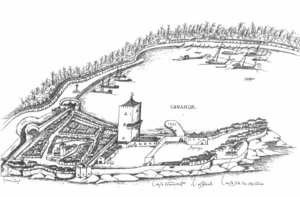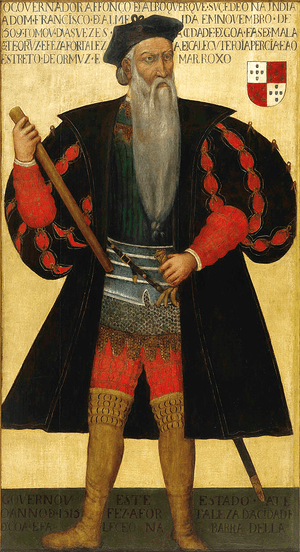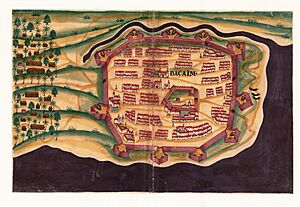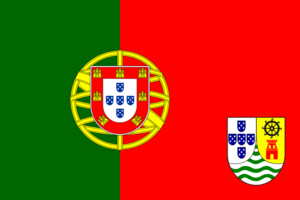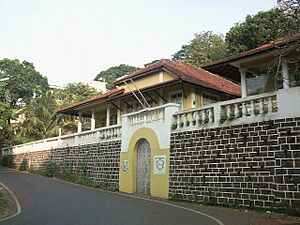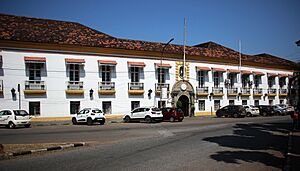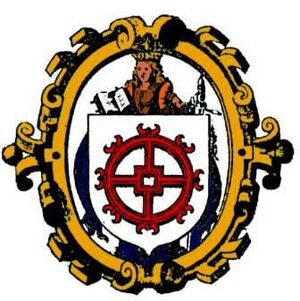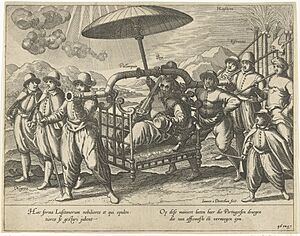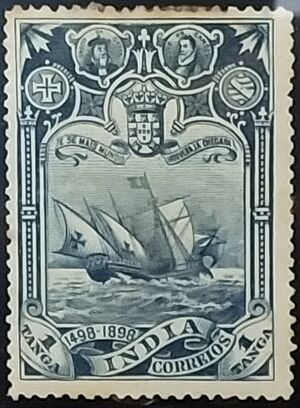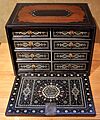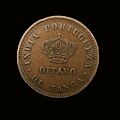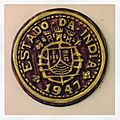Portuguese India facts for kids
Quick facts for kids
State of India
Estado da Índia (Portuguese)
|
|||||||||||||||||||||||||||||||
|---|---|---|---|---|---|---|---|---|---|---|---|---|---|---|---|---|---|---|---|---|---|---|---|---|---|---|---|---|---|---|---|
| 1505–1961 | |||||||||||||||||||||||||||||||
|
|
|||||||||||||||||||||||||||||||
|
Anthem: Hymno Patriótico (1808–1826)
"Patriotic Anthem" Hino da Carta (1826–1911) "Hymn of the Charter" A Portuguesa (1911–1961) "The Portuguese" |
|||||||||||||||||||||||||||||||
 |
|||||||||||||||||||||||||||||||
| Status | State of Portugal (1505–1946) Overseas province of Portugal (1946–1961) |
||||||||||||||||||||||||||||||
| Capital | |||||||||||||||||||||||||||||||
| Official language | European Portuguese | ||||||||||||||||||||||||||||||
| Common languages | |||||||||||||||||||||||||||||||
| Religion | Official: Roman Catholicism Major: Hinduism Islam Minor: Zoroastrianism Judaism |
||||||||||||||||||||||||||||||
| Demonym(s) | Portuguese | ||||||||||||||||||||||||||||||
| Monarch and Head of State | |||||||||||||||||||||||||||||||
|
• 1505–1521
|
Manuel I of Portugal | ||||||||||||||||||||||||||||||
|
• 1958–1961
|
Américo Tomás | ||||||||||||||||||||||||||||||
| Governor | |||||||||||||||||||||||||||||||
|
• 1505–1509
|
Francisco de Almeida (first) | ||||||||||||||||||||||||||||||
|
• 1958–1961
|
Manuel António Vassalo e Silva (last) | ||||||||||||||||||||||||||||||
| Historical era | Imperialism | ||||||||||||||||||||||||||||||
|
• Establishment
|
15 August 1505 | ||||||||||||||||||||||||||||||
|
• Indian Annexation
|
19 December 1961 | ||||||||||||||||||||||||||||||
| Area | |||||||||||||||||||||||||||||||
|
• Total
|
4,305 km2 (1,662 sq mi) | ||||||||||||||||||||||||||||||
| Currency |
|
||||||||||||||||||||||||||||||
|
|||||||||||||||||||||||||||||||
| Today part of | |||||||||||||||||||||||||||||||
The State of India (Portuguese: Estado da Índia), also known as Portuguese India, was a part of the Portuguese Empire. It was created in 1505, six years after the Portuguese explorer Vasco da Gama found a sea route to India. The capital of Portuguese India was the main center for many military forts and trading posts spread across the Indian Ocean.
The first viceroy, Francisco de Almeida, set up his main base in Cochin in 1505. This happened after the Kingdom of Cochin agreed to be protected by Portugal. In 1510, Portugal took over Goa from the Bijapur Sultanate. Goa then became a very important port for Portuguese ships arriving in India. The capital moved from Cochin to Goa in 1530.
Later, from 1535, Mumbai (Bombay) was a Portuguese port called Bom Bahia. It was given to Charles II of England in 1661 as part of a marriage agreement. The name "State of India" became common in documents around the mid-1500s.
Until the 1700s, the viceroy in Goa controlled all Portuguese lands around the Indian Ocean. This included areas from Southern Africa to Southeast Asia. In 1752, Portuguese Mozambique got its own government. From 1844, Goa stopped managing Portuguese Macao and Portuguese Timor. By the late 1700s, Portugal gave up many unofficial colonies due to strong competition from other European and Indian groups.
In later years, Portugal's control was limited to areas on the west coast of India. When the British left India in 1947, Portuguese India had three main areas: Goa (which included Anjediva), Damaon (which included Dadra and Nagar Haveli), and Dio districts. Portugal lost control of Dadra and Nagar Haveli in 1954. The rest of the territory was taken by India in December 1961. Portugal officially recognized India's control in 1974, after a big change in its own government.
Contents
Portuguese Explorers Reach India
Vasco da Gama's First Trip
The Portuguese first arrived in India on May 20, 1498. Vasco da Gama landed in Calicut on the Malabar Coast. He tried to trade with the local ruler, the Zamorin. However, the Portuguese could not pay the required taxes in gold.
Calicut officials held Gama's men as payment security. This made Gama angry, and he took some local people and fishermen by force. Despite this, Gama's trip was very successful. The goods he brought back were worth 60 times the cost of his journey.
Pedro Álvares Cabral's Journey
Pedro Álvares Cabral sailed to India in 1500 to trade for spices like black pepper. On his way, he reached Brazil. He set up a trading post in Calicut, but it was attacked by locals. More than 50 Portuguese died.
Cabral was very angry. He seized 10 Arab merchant ships, killed about 600 crew members, took their goods, and burned the ships. He also bombed Calicut for a whole day. Cabral made good agreements with rulers in Cochin and Cannanore. He returned to Portugal in 1501 with only 4 of his 13 ships.
In 1502, the Portuguese built another trading post in Pulicat. Its location was great for a natural harbor.
The third Portuguese trip to India was led by João da Nova in 1501. His main goal was to get spices. On the way, his fleet discovered Ascension Island and Saint Helena. Even though it was a trade trip, his fleet fought with the Zamorin's ships near Calicut. This was the first major naval battle for Portuguese India.
Vasco da Gama's Second Trip
Vasco da Gama returned to India in 1502 with 15 ships and 800 men. He arrived in Calicut and demanded that all Muslims leave the city, but the ruler refused. Gama then bombed the city and captured several rice ships.
While in India, Gama also attacked Onor and made a trade agreement in Cananore. He fought another battle with the Zamorin's fleet in 1503. He went back to Portugal in September 1503.
Afonso de Albuquerque's First Visit
In 1503, Afonso de Albuquerque commanded his first expedition to India. His team built a fort in the allied kingdom of Cochin. They also made a short-lived peace agreement with the Zamorin and opened a new trading post in Kollam.
Lopo Soares de Albergaria's Expedition
The sixth Portuguese expedition to India was led by Lopo Soares de Albergaria. He bombed Calicut and helped the Portuguese soldiers in Cochin defend against a large attack. He also made an alliance with the king of Tanur and captured an Egyptian trade fleet.
Building the State (1505–1515)
Francisco de Almeida, First Viceroy
On March 25, 1505, Francisco de Almeida became the first Viceroy of India. His job was to build four forts on India's southwestern coast: Anjediva, Cannanore, Cochin, and Quilon. Almeida left Portugal with 22 ships and 1,500 men.
On September 13, Almeida reached Anjadip Island and began building Fort Anjediva. On October 23, with permission from the ruler of Kōlattir, he started building Fort St Angelo of Cannanore. He left Lourenço de Brito in charge with 150 men.
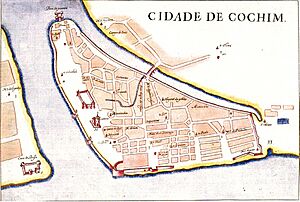
By October 31, 1505, Almeida reached Cochin with only 8 ships. He learned that Portuguese traders in Quilon had been killed. He sent his son, Lourenço de Almeida, with 6 ships. They destroyed 27 Calicut ships in Quilon harbor. Almeida settled in Cochin and made Fort Manuel stronger.
The Zamorin prepared a fleet of 200 ships to fight the Portuguese. But in March 1506, Lourenço de Almeida won a sea battle at the harbor entrance. This was a big defeat for the Zamorin's fleet. Lourenço de Almeida also explored the coast south to Colombo in Sri Lanka. In Cannanore, a new ruler attacked the Portuguese fort, leading to a siege.
In 1507, Almeida's mission got stronger with more ships. However, in March 1508, Lourenço de Almeida's squadron was attacked by a combined Egyptian and Gujarati fleet. Lourenço de Almeida died in this battle. But the Mamluk-Indian forces were defeated in the Battle of Diu in 1509.
Afonso de Albuquerque, Second Governor
In 1509, Afonso de Albuquerque became the second governor of Portuguese lands in the East. After getting their first protectorate in Portuguese Cochin, a new fleet arrived with orders to destroy the power of the Zamorin of Calicut. The Zamorin's palace was captured and burned. His forces fought back, killing one Portuguese leader and wounding Albuquerque. Albuquerque retreated. After the Zamorin was killed in 1513, Albuquerque made a deal with the new ruler to protect Portuguese interests, and a fort was built in Calicut.
In 1510, Afonso de Albuquerque captured Goa from the Bijapur Sultanate with help from a Hindu leader named Timoja. This led to a permanent Portuguese settlement in Velha Goa (Old Goa). Goa became the main seat for the viceroy, who ruled all Portuguese lands in Asia.
Albuquerque also added the cities of Malacca (in 1511) and Ormus (in 1515) to the State of India. He encouraged his soldiers to settle down and marry local women. By the mid-1500s, there were about 2,000 "married men" (casados) in Goa. Goa had many local non-Portuguese people for the Portuguese to rule. Albuquerque allowed different religious groups to live by their own laws. However, he stopped the practice of sati. He also gave property rights to local women for the first time. In Goa, he started a fund for orphans and opened a hospital.
Albuquerque's policies were very popular with his soldiers and the local people because he was fair. When he died in 1515, even the Hindu people of Goa mourned him. His tomb became a shrine where local Hindus would leave flowers and pray for justice. His remains were returned to Portugal in 1566.
The Portuguese also sent "Orphans of the King" (Órfãs do Rei) to their colonies in India. These were orphaned Portuguese girls supported by the King. They were sent to marry Portuguese settlers or important local people.
Portuguese India: 16th to 17th Century
In 1520, the Portuguese expanded their control over the town of Rachol. This happened when Krishnadevaraya captured the Rachol Fort and gave it to the Portuguese. They had a deal to help each other against other Indian states.
In 1526, John III of Portugal gave Goa the same legal status as Lisbon. This meant Goa had its own laws and privileges, which was important because local laws were not yet written down.
The Portuguese also had settlements around the Coromandel region. They built the first church in Madras (Chennai) in 1516. They also built important Christian pilgrimage sites like the Basilica of Our Lady of the Mount, Bandra and the Our Lady of Velankanni shrine.
Several areas were also taken from the Sultan of Guzerat in the north. These included Daman (1539), Salsette, the seven islands of Bombay, Chaul, and Bassein (Vasai) (1534), and Diu (1535). These areas became known as the Northern Province of Portuguese India. It stretched about 100 km along the west coast. The main city of Portuguese Bombay was around the Bassein Fort.
In 1538, the Ottoman Empire tried to capture Diu with a large fleet and army. However, the Portuguese successfully defended Diu. This victory is famous in Portuguese history.
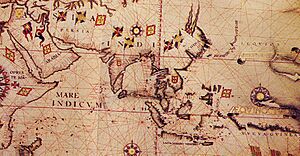
In 1546, the missionary Francis Xavier asked for the Goa Inquisition to be set up. This was a religious court. Non-Christians faced difficulties even before it started. Francis Xavier helped convert many fishermen. In the same year, the Portuguese fort of Diu was attacked a second time.
In 1556, the first printing press in Goa was set up in India. It helped share European knowledge and customs. The Jesuits later brought this printing technology to China and Japan.
By the early 1600s, Goa and its surrounding areas had about 250,000 people. Portugal needed to send many men and supplies to hold this land against attacks. Portuguese victories, like the defense of Diu in 1509 and 1538, and the conquest of Goa in 1510, were achieved with limited soldiers. The Portuguese had about 2,000 to 3,000 European and mixed-race troops, plus local helpers. Indian states could have tens of thousands of soldiers. The Portuguese won because of their better military technology (ships and cannons), training, and tactics. Also, the Indian states often fought among themselves.
Later Years: 17th to 20th Century
The 1600s
The seven islands of Bombay were given to the English Crown in 1661 as part of the dowry of Catherine Braganza when she married Charles II of England. The English king then leased the area to the English East India Company.
In 1683, the Marathas tried to attack Portuguese settlements in the Konkan region, but they did not succeed.
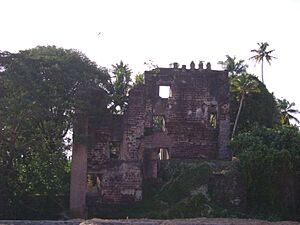
Kollam (Quilon) was an important port and became a Portuguese settlement in 1519. They built a cemetery there. After the Dutch took over, they also buried their dead there. Parts of this cemetery still exist today.
The 1700s
Most of the Northern Province, including Taana, Bassein (Vasai), and Chaul, was lost after another Maratha invasion in 1739. Goa, Daman, Diu, and Anjediva were kept because new Portuguese ships and a viceroy arrived from Lisbon.
In 1752, Mozambique became separate from Portuguese India and had its own governor.
After battles and losses, the Portuguese expanded Goa's territory between 1763 and 1788. This new land was called the Novas Conquistas. The Jesuits were expelled from Portuguese lands in 1759. They were replaced by local Goan Catholic religious groups. A college for local elites was opened, and the Goan Inquisition was ended. The King declared that native Christians were equal to Europeans, and religious freedom was allowed.
In 1783, the Marathas gave control of Dadrá and Nagar Áveli to the Portuguese. The Portuguese then bought Dadrá in 1785. By 1818, the Portuguese fully controlled Nagar Áveli.
The 1800s
British troops occupied Goa from 1799 to 1813 because France planned to take it. Goa was briefly a British Protectorate. The Portuguese governor managed to keep control of civil matters.
In 1843, the capital moved to Panjim (New Goa). It officially became the main administrative center, replacing Old Goa. In 1844, the Portuguese governor of India stopped managing Macao and Timor. From then on, Portuguese India was only in the Indian subcontinent.
World War II
Portugal stayed neutral during World War II. Because of this, Axis ships (German and Italian) took shelter in Goa to avoid being captured by the British. One German ship, the Ehrenfels, started sending information about Allied ship movements to German submarines. This was very harmful to Allied shipping.
The British Navy could not officially act against these ships because Goa was neutral. So, the British Special Operations Executive supported a secret raid. Members of a civilian unit called the Calcutta Light Horse sailed to Goa and sank the Ehrenfels. The British then sent a fake radio message saying they would seize the territory. This made the other Axis crews sink their own ships, fearing they would be captured.
This raid was kept secret until 1978 to avoid political problems with Portugal. In 1980, the story was made into a movie called The Sea Wolves.
1945 to 1961
On July 24, 1954, a group called "The United Front of Goans" took control of Dadra. Nagar Haveli was seized by another group on August 2, 1954.
India broke off diplomatic relations with Portugal and demanded that Portugal close its offices in India. India also put an economic ban on Portuguese Goa. From 1955 to 1961, India tried to solve the issue peacefully and brought it to international attention.
To help transport people and goods to and from the Portuguese areas, Portugal started an airline and built airports in Goa, Daman, and Diu.
In December 1961, India invaded the remaining Portuguese lands. Portuguese forces were ordered to fight or die. However, the Governor of Portuguese India signed the surrender document on December 19, 1961. This ended 450 years of Portuguese rule in India.
After Portuguese Rule
New Territories in India
Free Dadra and Nagar Haveli was independent from 1954 until it joined India in 1961.
After the takeover, Goa, Daman and Diu became new territories of the Indian Union. Goa had its first elections in 1963.
In 1967, a vote was held to decide if Goa should join the state of Maharashtra. The group that wanted Goa to stay separate won. Goa became the 25th state of India on May 30, 1987. Dadra and Nagar Haveli, Daman, and Diu became separate territories.
After 1961, big changes happened in Portuguese India. Democratic elections were introduced, and English replaced Portuguese as the main language for government and education. After many years of protests, Konkani became the official language of Goa, Daman, and Diu in 1987. India allowed some Portuguese systems to continue, like the land ownership system. Goans also kept the Portuguese Civil Code of Goa and Daman, which means they have a common civil code that applies to everyone, regardless of religion.
Citizenship
The Indian government granted Indian citizenship to all people born in Goa, Daman, and Diu on or before December 20, 1961.
India and Portugal Relations
Portugal did not recognize India's control over the annexed territories at first. They even had a government-in-exile for these areas. However, after a change in the Portuguese government in 1974, Portugal recognized India's control. The two countries then restored diplomatic relations. Portugal now automatically gives its citizenship to people from former Portuguese India and opened a consulate in Goa in 1994.
How Portuguese India Was Run
From 1505 until 1961, a governor or viceroy was the highest authority in Portuguese India. They usually served for three years and controlled all Portuguese lands east of the Cape of Good Hope. They were military commanders and administrators, handling armed forces, diplomacy, trade, and money. They received written orders before leaving Portugal. Governors and viceroys lived in the Palácio do Hidalcão in Goa.
The most important administrative parts were set up in the 1500s. These included the high court, the finance office, and the military supply office.
However, Portuguese lands were very spread out, so the State was not very centralized. Individual fort captains and town halls had a lot of power far from Goa. Like governors, fort captains served for three years, but their terms could be extended.
The Church was very important. The Pope gave the Kings of Portugal special rights to support the Church in their overseas lands. After 1557, Goa became the seat of an archbishop. Religious groups like the Augustinians, Franciscans, Dominicans, and Jesuits set up missions in Goa. This gave the Catholic Church a strong presence and influence, earning Goa the nickname "Rome of the East."
Most important settlements had a "town hall" (câmara). These were similar to town halls in Portugal and played a big role in local government. They collected some local taxes and acted as a first court.
The State also ruled over non-Portuguese and non-Christian people. Often, their traditional local systems were kept in place. When Afonso de Albuquerque captured Goa, Hindu residents kept their lands. The old system of land ownership was kept, and tax collection was left to Hindu leaders. However, later, Brahmins were excluded from Portuguese administration, leading to many conversions to Christianity.
Trade and Economy
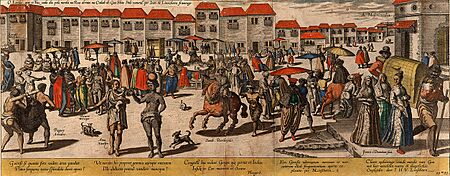
Trade was a main reason for Portugal's expansion overseas. A key goal of Portuguese India was to take over the trade between Europe and Asia. This trade used to go through the Red Sea and Persian Gulf. Portugal wanted to redirect it around Africa. Trade was done by the Crown through royal agents or by independent merchants.
One main job of royal agents was to get spices to send back to Europe. In 1503, the Portuguese brought 30,000 quintals of spices to Lisbon. This was more than what Venice brought to Europe through Egypt. Most of the goods imported to Europe by the Portuguese was black pepper. After 1520, the Crown controlled all pepper trade. The Portuguese got most of their pepper from Kerala or Kanara in India. For most of the 1500s, Portugal supplied most of Europe's pepper. The Crown also controlled trade in cloves, nutmeg, cinnamon, silk, and the export of gold and silver from Portugal to Asia.
The Portuguese Crown set up official "runs" (carreiras) connecting Goa to major ports around the Indian and Pacific oceans once a year. At first, royal ships did this, but after 1560, the Crown started leasing these routes to private companies. By the late 1500s, the value of these trade leases was very high.
Portugal controlled Indian Ocean trade by using a system of safe-passes called cartaz. This was most effective on India's west coast. The Portuguese Crown also collected high customs taxes, especially in Goa, Hormuz, Malacca, Bassein, and Diu. In the 1580s, these taxes made up over 85% of the viceroy's income.
Independent Portuguese merchants also got involved in trade within Asia. The main group of informal Portuguese traders were mixed-race merchants, descendants of Portuguese soldiers or merchants who married local women. Their main center was Goa, where about 2,000 "married men" (casados) and their families lived. They mostly traded in Gujarati cotton textiles, but also Kerala pepper, Sri Lankan cinnamon, and diamonds from southern India. By 1520, they traded in almost every important commercial area in Asia, except Japan (which they reached in the 1540s). Macau was founded by independent Portuguese traders.
The Portuguese India Company was created in 1628, but it closed five years later. By then, Portugal's share of the pepper trade had fallen behind the Dutch East India Company and the East India Company.
Portuguese trade was greatly reduced by wars with the Dutch. After a peace treaty in 1663, trade continued mainly with Gujarat and Madras. Indian cotton became the main export from Portuguese India. Tobacco from Portuguese Brazil became a very important product traded across Asia through Portuguese India until the 1800s. New Portuguese East India Companies failed later. By the 1700s, tobacco, firearms, and consumer goods were important items traded in Portuguese India. Exports back to Europe included silks, spices, and Indian cottons. Goa became a commercial partner of British Bombay. Many Indo-Portuguese merchants became important in French, Danish, and especially British trading posts.
Society and Culture
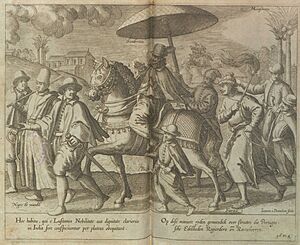
Portuguese India was mostly urban, meaning it had cities and towns. Its purpose was to provide safe places for trade and communication. Only Goa, Daman, Bassein, Chaul, and Colombo had significant rural populations. After a massacre of Portuguese traders in Calicut in 1500, almost every Portuguese possession was fortified with strong defenses.
Portuguese India had a society that was officially Christian and European, but it was also influenced by the non-European setting. At the top were European-born viceroys, officers, and clergy. Below them were Portuguese "married men" (casados) and their mixed-race descendants, who could be wealthy merchants. Finally, there was the native society. At their peak in 1600, there were about 5,500 Portuguese casados across the State. Many casados lived a very relaxed and luxurious lifestyle compared to Europeans. They had nice houses, many servants, and a variety of food. Goan casados often wore shirts and white trousers, while their wives usually wore saris.
Besides forts, churches dominated the skyline of most Portuguese settlements, especially in Goa. This gave the city a strong European and Catholic feel. About 600 clergy lived in Goa in 1630. However, Europeans and Christian mixed-race people were always a minority in any Portuguese settlement. They made up perhaps only 7% of Goa's population. The rest were Hindus, Indian Christians, other Asians, and Africans.
Because of this mix, the culture of Portuguese India was a blend of East and West. Church buildings combined Portuguese and Asian art styles. Daily life, including furniture, clothing, and food, was often more Asian than Portuguese.
Postal History
The early history of mail in the colony is not clear. But regular mail was sent to and from Lisbon starting in 1825. Portugal had a postal agreement with Great Britain, so much mail likely went through Bombay on British ships. Portuguese postmarks are known from 1854, when a post office opened in Goa.
The last regular stamps for Portuguese India were issued on June 25, 1960. These were for the 500th anniversary of Prince Henry the Navigator's death. Indian stamps were first used on December 29, 1961. However, the old Portuguese stamps were accepted until January 5, 1962. Portugal continued to issue stamps for the lost colony, but they were not sold in the colony's post offices, so they are not considered valid.
Using both Portuguese and Indian stamps on mail was allowed from December 22, 1961, to January 4, 1962. Portuguese postmarks were allowed until May 1962.
Images for kids
-
Depiction of a Portuguese gentleman in the Moghul Empire
-
Obverse: Lettering "CARLOS I REI DE PORTUGAL MCMIII", portrait of King Carlos I.
See also
- Portuguese Empire
- Códice Casanatense
- Japan Voyage
- Estado Novo (Portugal)
- Indo-Portuguese creoles
- List of governors of Portuguese India
- Arquivo Histórico Ultramarino (archives in Lisbon documenting Portuguese Empire, including India)
- Portuguese Indian rupia
- Portuguese Indian escudo
- Goa liberation movement
- Civil code of Goa and Damaon
- Cuncolim Revolt
- Portuguese Bombay and Bassein
- Portuguese Ceylon
- Portuguese Oman
- Colonial India
- Mughal–Portuguese conflicts
- Portuguese Negapatam




